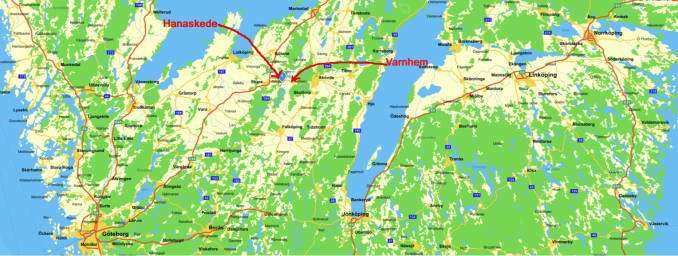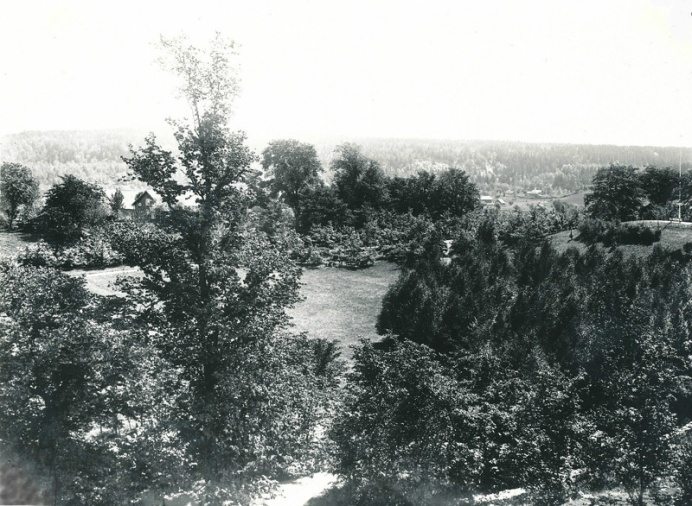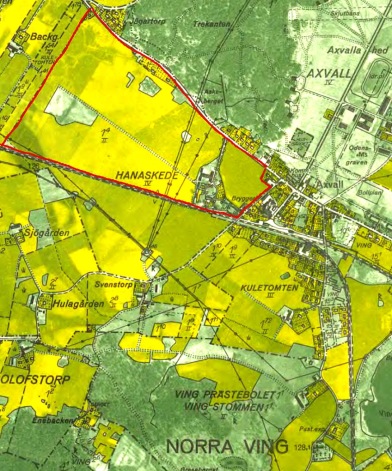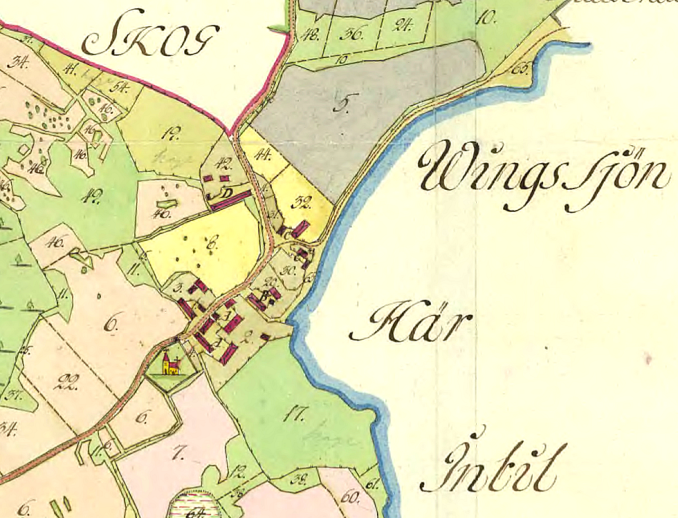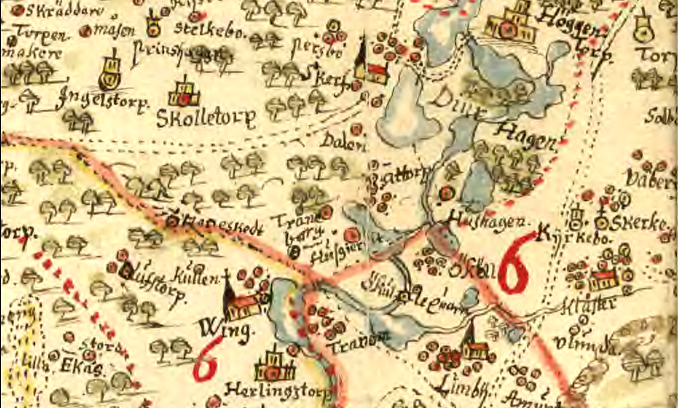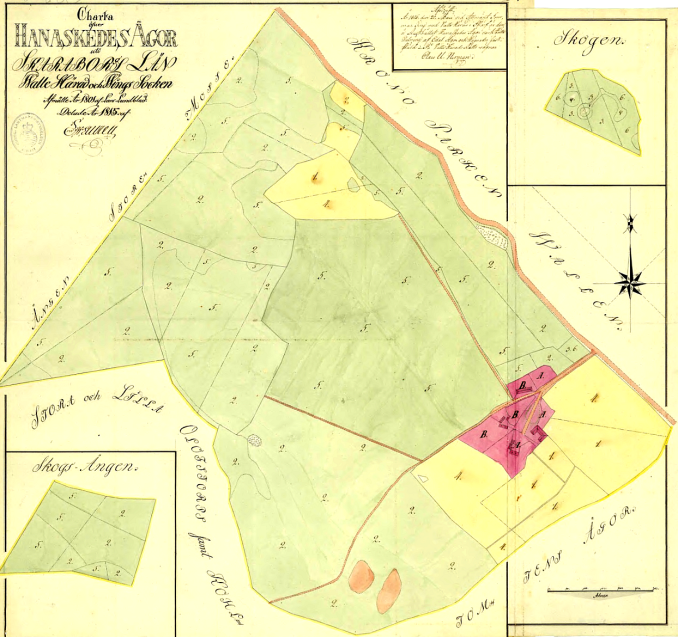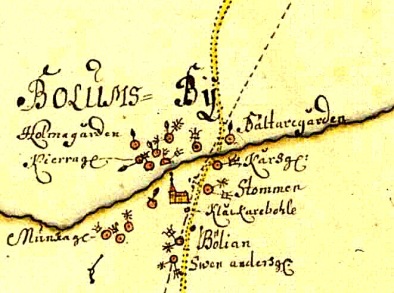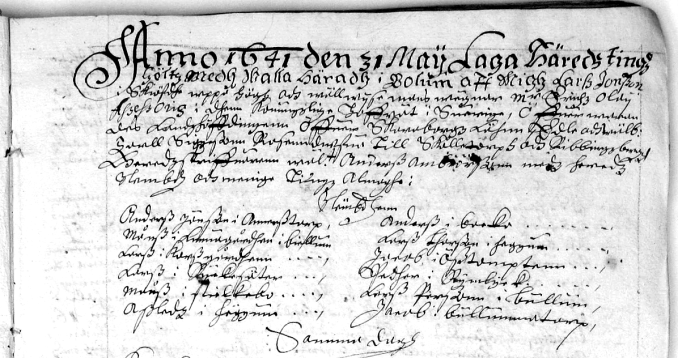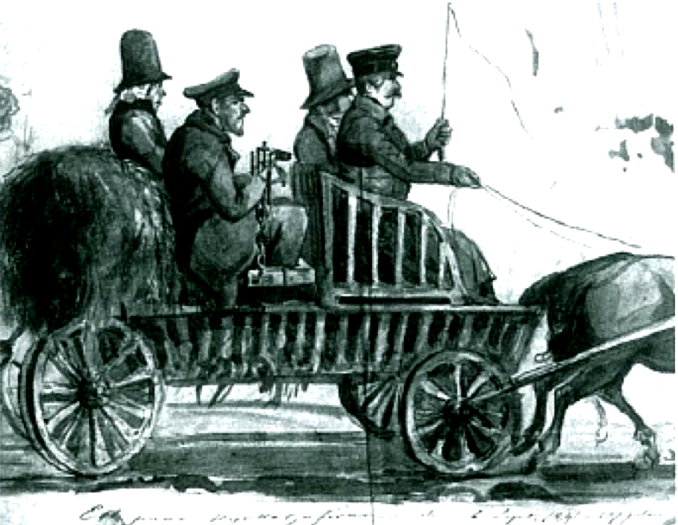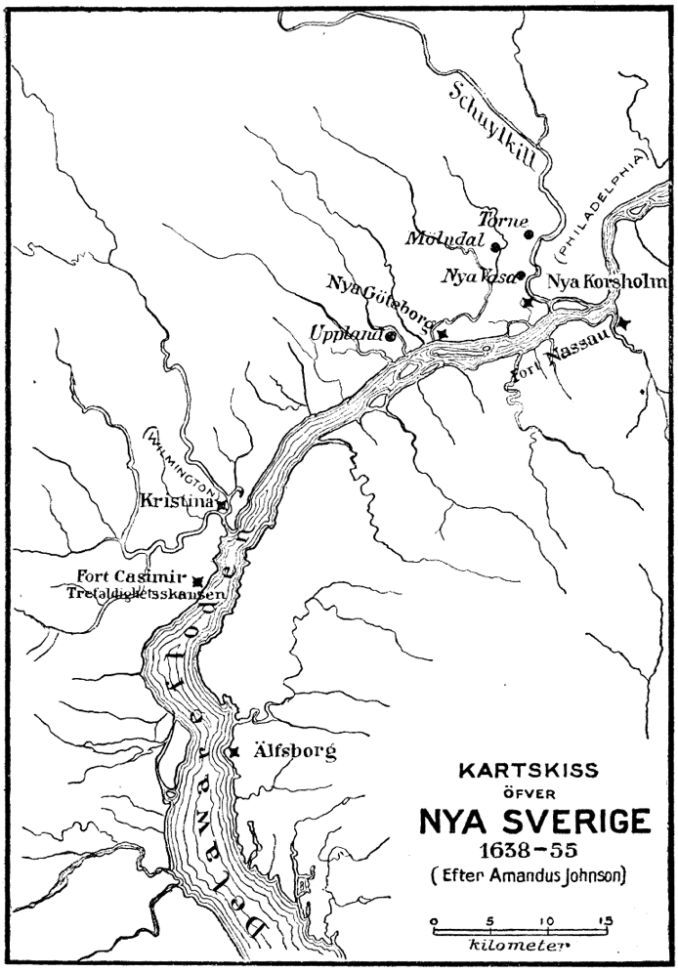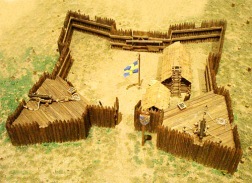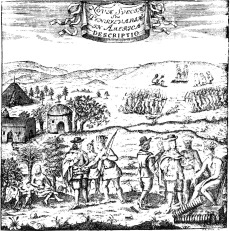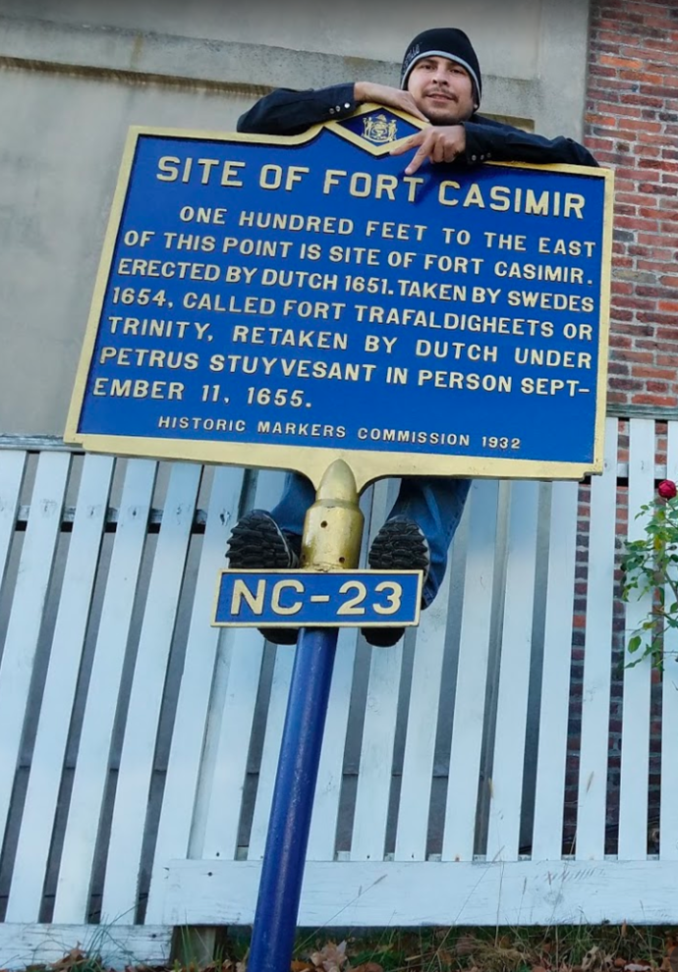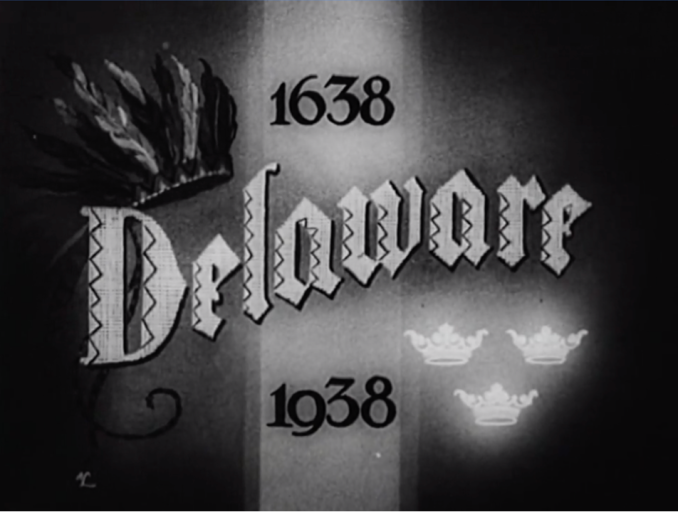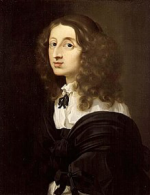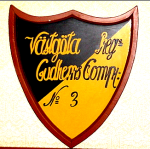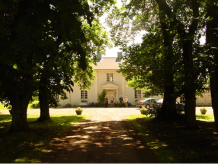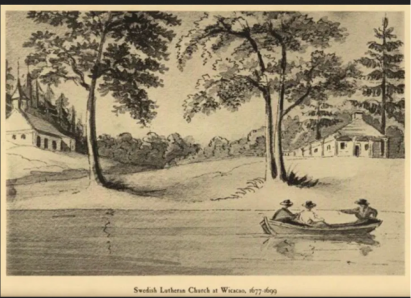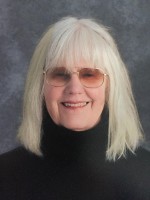The Abbey garden in Varnhem acquired by the Crown after 1527: The history of chopped down fruit trees 100 years later, a death sentence and the colony of New Sweden in colonial America - A very unlikely story
Prelude
Translator to English for this page is Douglas Byrne, Skarke-Varnhem historical society
This one of a kind story that we are about to tell actually starts in Hanaskede, Wing (Axvall), with the birth of Hans Månsson in 1612.
Mary Ann Royal, USA, searched for relativs in this part of the world due to DNA-research. And in the digital age, she was able to trace her family tree back 10 generations to discover Hans Månsson, her direct ancestor. The Skarke-Varnhem historical society decided, with Mary Anne’s help, to tell this unique historical story and this page is the result of our efforts.
Mary Anne got in touch with the Skarke-Varnhem historical society after recommendation from a facebook group member. Mary Anne and the society have been able to gather a lot of material surrounding this astonishing story of Hans Månsson, the Crowns abbey garden in Varnhem and the death sentence in the Valle judicial district that was changed to exile to the colony of New Sweden in North America on 7 November 1641.
A short summary of this unbelivable history and New Sweden
For our foreign readers we present the location of Varnhem and Hanaskede on a bigger map here
On the map you can find Gothenburg (Göteborg) in the left down corner and about 170 km from there, Hanaskede farm near the village Axvall (historical "Wing parish") and further on 5 km you find the Village of Varnhem. All between the two big lakes Vänern and Vättern.
The historical background of the abbey and abbey grounds
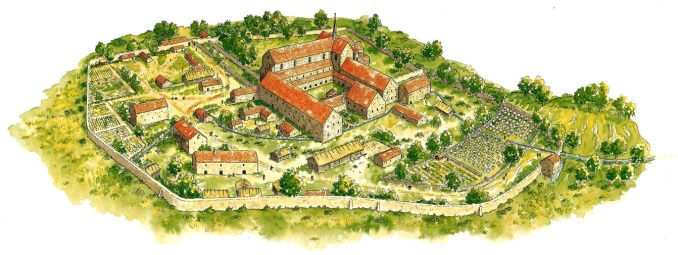 Monastry of Varnhem about 1350. Bo Södervall "Varnhems Monastry about 1350. In cooperation with Jan O.M. Karlsson and Ragnar Sigsjö, 1984. Varnhem. Rekonstruktion. Akvarell. Illustration.
Monastry of Varnhem about 1350. Bo Södervall "Varnhems Monastry about 1350. In cooperation with Jan O.M. Karlsson and Ragnar Sigsjö, 1984. Varnhem. Rekonstruktion. Akvarell. Illustration.
The following is a summary of a academic dissertation from 1854: "Walle härad i Westergötland"
(“Walle judicial district in Västergötaland”) Authors: August Florén and Erik Svedelius with our own comments to simplify the reading.
There was a lot of back and forth in 1148 when Mrs. Sigrid donated lands and farms to the monks from France who started to build an abbey, forced to leave and then returned.
1234: Fire ravaged the abbey and left it in ruins a catastrophe that turned in to rebirth due to the initiative taken by Birger Jarl and other financiers of the middle ages to rebuild the abbey again but this time more beautiful and splendid than before.
A beautiful garden was built and was strictly protected even in later years. The abbey was big and the monks had several buildings around the abbey even to the southwest of the church.
1394: The abbey and church was once again burned. This time as a result of a feud between partisans of Margareta and Albrecht. The Church and abbey were soon repaired.
The parliament of 1527, aka the Västerås Parliamment, convened in Västerås 16-18 June 1527 and became also known as the “Reformation Parliament” or in other words, the parliament approved Gustav Vasa`s wishes to divest the church of its power and cut ties with Rome.
This parliament can be seen as the start of the reformation in Sweden and the start of Lutherism. What the the theology of the Swedish Church would be was hotly debated long after the decision of the parliament up until the Uppsala meeting in 1593. The result of the Västerås parliament was the “Great Reduction” which took away the economic and judically power of the church and increased the resources and power of the crown instead.
As a result, the crown gained control over all the assets of the abbey including all farms, lands and mills. “The Varnhem abbey, in Valle district only, owned between 70 and 80 farms”. These too were taken over by the crown. As about the 200 more farms who was owned by the abbey troughout Sweden.
As a result of the Västerås parliament, the abbey in Varnhem met the same fate as other abbeys around the country. All of their assets were seized by the crown. However, the monks were able to remain as long as they paid a tax to the crown.
Later the monastry was given to certain members of the nobility on the condition that they maintained it and paid tax. Due to that burden, the abbey and church fell in to disrepair and in the end, was burned once again, but this time by the Danes during the Nordic Seven Years war.
The abbey and church was left abandoned and nearly in ruin until Duke Carl (1550-1611), later Charles IX, was given Valle district and he noticed the importance of the forgotten abbey. Here is a letter Duke Carl wrote to King Johan about the state of the abbey and church and what should be done about it.
“Our brotherly loving greetings with much love as we are able to give, to your Royal Majesty with god the almighty always near, all powerful high born King beloved dear brother; We can not hold back your majesty, with love and fraternity, we visited Varnhems Abbey and church which is a holy temple, while we are here in Västergötland.
As your majesty already knows, the church is standing only with the help of one roof. The walls and vaults have fallen in to disrepair of which the damage is large scale and dramatic. It would be therefore useful that the same wonderful temple in time to support the roof given the great costs that have been previously used by kings and the kingdoms nobility who have passed and are buried.
And it will be difficult for our subjects that live in in Valle district to bear the burden alone to cover the church. Your majesty for this sake should allow other districts in Västergötland that are close by help. From our side we also want to help with the burden of restoring the church by providing planks, nails and other material that is needed and when possible.
This is what we want to our fraternal and loving Royal Majesty as well as his Majesty´s loving wife and dear children commanded in god the Almighty´s merciful protection and care to a long and great reign - always fraternal and loving.”
To know the letter had the intended impact, one only has to read King Johan´s letter to Lasse Matsson, Baliff, in Skånings and Gudhems districts; “To let the peasants in his charge to chop wood and take it to Varnhem´s abbey.”
However, the complete renovation of the church would not be complete until many years later when count Magnus De la Gardie took charge.
Count Magnus De la Gardie visited the site and decided that it would be the perfect place for the family burial plot. After that he fulfilled the mission to fully restore the church.
1647 Queen Kristina gifted Höjentorp castle along with Varnhem church and abbey as wedding present to Count Magnus De la Gardie and his wife Maria Eufrosyne. Count Magnus De la Gardie visited the site and decided that it would be the perfect place for the family burial plot. After that he fulfilled the mission to fully restore the church.
De la Gardie also added a school and a hospital in conjunction with the restoration of the church. See more about that here: Skara Hospitals tilldelade trädgård i Varnhem (Skara Hospitals assigned garden in Varnhem)
From 1668-1671 according to the inscription on the now fully restored church, expensive burial chambers were built with inscriptions for the princes buried there. A mausoleum for De la Gardie himself and his family occupied the entire southern sacrum. Probably due to the “Great Ruduction”, there was no provision in the contract to pay for the maintenance of the church and burial chambers, but his relative, Elisabeth Oxenstjerna later made a financial arrangement and in so doing, established the De la Gardie grave fund.
1682 The count fell in to disgrace and was forced to return all of his properties to the crown. He died a pauper in 1684.
The hospital was allowed to take control of its own assets and that of the abbey garden the a royal letter on 25 January 1689 and later the hospital was give Bille mill and dividends from a part of Björsgården. See the page about: Björsgården under Skara Hospital
Carl XI made the abbey church the mother church of the parish through a letter dated 23 February, 1695. one reason given is “Since the church is the biggest and most beautiful in the area and is in close proximity to the royal estate of Höjentorp, the abbey church should be given that distinction.”
Skara Hospital used the garden until 1832 when the hospital ceased to exist. In Överbo village, Varnhem, there lived gardeners whose job it was to grow vegetables and fruit for the hospital.
In 1880 the garden was bought by Varnhem parish for use as a church park.
The Hospital Garden´s new church park after purchase in 1890
The horseman, Hans Månsson from Hanaskede cuts down fruit trees from the royal garden in 1640 in Varnhem to make mane combs for the farms horses - sentenced to death - presented with an alternative to be exiled to New Sweden to help Sweden form a colony in America.
We start with the story of the horseman from Hanaskede born 1612; Hans Månsson and his family at Hanaskede.
Hans Månsson, born 1612, was the son of the horseman of Hanaskede, Lieutenant Måns Persson, born in Lanna 1595- died 1637, 42 years old.
His parents were Per and Ingeborg Östensson, born 1570 and 1572. Per was from Nordmaling in Västerbotten and Ingeborg was from Kisa, Östergötland.
When Måns became a corporal in the Väsgöta cavalry regiment, his assigned living quarters was in Hanaskede in Norra Wings parish.
Hans´mother was Måns first wife, Brita Lillebielke* who most likely died in 1612, when Hans was born. She was only 16 when she and Måns married in 1611.
Kerstin Haaskede** became Måns second wife and she was born in 1590 in Hanaskede, they had a child. Kerstin died in 1648, 58 years old.
Kerstin was the woman Hans considered to be his mother when growing up. Kerstins widowed mother, Gunilla also lived in Hanaskede and played an active role in Hans´ upbringing. It was clear that Hans would follow in his fathers footsteps becoming a horseman and taking over Hanaskede from his father.
After his fathers death, Hans was drafted by the governor at Vings Kyrkebacke and later drafted in the spring by the Västgöta regiment under Hans Stake from Kinnekulle. Hans would be part of the German campaign 1638-1640.
From information gathered through family accounts and the book “Hanaskede Ryttare” by Marc Cantoni, 1997.
*The Lilliebielke family is an ancient (a family freed from having to pay tax) “Free family”. A branch of the the family was ennobled in 1648.
**Haaskede is probably the result of Hanaskede misspelled. It’s more than likely the children took the name of the farm as their last name.
Hanaskede - A single military farm on Crown property with the residents belonging to Wing parish, but the farm was not part of Wing village (later Norra Wing)
Map of Hanaskede and Abbey village on a map from 1655
A map of Hanaskede from 1815 - two families own and share the farm
Hans Månsson returns from the war in Germany and meets Heideridaren Lars Jönsson in Skarke and chops down a fruit tree for the hard wood for farming tools and mane combs for horses
The story below is based on the book “Ryttaren från Hanaskede” (The Rider from Hanaskede) and confirmed sources. The book is a novel that includes facts and sources from that time period
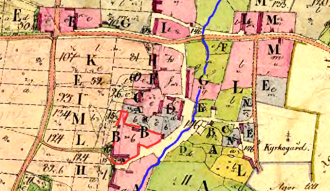 Ryttargården 1805 was placed at the same location as in 1640- littera B - marked with red lines - the churh is to the right (east) on the map and behind the Garden
Ryttargården 1805 was placed at the same location as in 1640- littera B - marked with red lines - the churh is to the right (east) on the map and behind the Garden
Before the riders reached home when they returned from the war, they met Heideridaren* Lars Jönsson from Skarke parish at Slafsens outlet at Horborgasjön.
He demanded a wolf hunt but they wanted to go home first. Then the governor Carl Siggesson Rosendufva, was to join the group at Varnhem Abbey that evening was it necessary that a few of the men followed Lars there so they could directly could ask the governor permission to change the time of the hunt. Hans was one the men to follow Lars there. After meeting Hans, Lars Jönsson knew who he was and made it a point to remember him. Lars became angry that that the riders wanted to meet the governor first to ask for a new time for wolfhunting, instead of following his orders to hunt - he was indeed also a man of the Crown!
Lars Jönsson offered the party provisions from his Ryttaregården which was a bit from the church with a clear view of the area around the abbey. At first they followed down to the abbey area and the governor stopped when he suddenly realized the situation for the riders who just returned home from the war. They were given apples and found out that the crown allowed the Heideridaren to pick apples from the garden that previously belonged to the monks as part of his salary. This is when Hans found out that there were old apple trees behind the church to the east.
The Riders from the surrounding farms patrolled the farms in the area from time to time and they ended up setting up camp for the night in Varnhem by the abbey walls. They noticed the garden looked thinned out and depleted**. They thought as though the garden was desolate.
It was then that Hans started to wonder if the the hard wood from the fruit trees would be good enough to make some farming tools for Hanaskede. He thought that it would be ok if he later turned to get some of the trees. On the way home he made up an excuse to return to Varnhem. After sneaking back to the garden he began to choose which apple trees he wanted to chop down. But first to be chopped down were some large crooked berry trees.
**Comment: We really don’t know what the condition of the garden was at this time. We do know from reading what the monks wrote that the garden with an apple orchard and vegetable patch for the entire monastery was beautiful and lush.
The decisions made by the parliament of 1527 regarding the reduction and reformation led the Varnhem monastery in to a new age. The Crown owned the monastery but members of the nobility held responsibility for it and for a short time the monks were able to continue to live there. The last monk left Varnhem in 1540 leaving the Crown to manage the garden.
We do knw that after a while, the monastery was almost in ruins but we don’t know if the gardens met the same fate. The Danes destroyed the church and monastery in 1566. However, we do know that the garden was in good enough condition for the crown to donate it to to the Skara Hospice in 1689 as a vegetable garden and fruit orchard. More than likely the garden was dilapidated to some extent and not as beautiful as when the monks had it. We draw the conclusion that the garden was recognizable as such in 1640, about 100 years after the reduction to the Crown and it was most certainly not abandoned. Indeed, everybody knew that the garden(land belonged to the Crown and its access was restricted for people to use.
The loud sound of chopping could be heard as far as the village and the potential of a poacher was brought to the attention of the Heideridaren Lars Jönsson who in turn gathered a posse, caught Hans in the act and arrested him on the spot. By the time of his arrest, Hans had already chopped down six apple trees and two cherry trees. Lars Jönsson was more than satisfied to get his revenge on the brazen riders refusing to go on the wolf hunt when ordered to.
Called to the scene was the governor, Carl Siggesson. He could not show any leniency in front of the people he governed. He became distressed that the punishment for the crime would be either execution or a very long prison sentence. Therefore, an investigation was opened which Hans signed and agreed to according to protocol. Hans was placed in custody of the district court and was placed under house arrest until he could be interrogated.
In April, jurors in Valle and the governor held a pre-trial conference before the court and the governor had no other choice but request a judgement in the report he would write giving the county’s account of the incident.
The case moved quickly through the chambers of government and was taken up by the advisory council. Higher powers intervened to show Hans mercy by giving him a choice of deportation to New Sweden in America or execution,
*Heideridare = (an obsolete term) was basically a royal forest warden/ranger who watched over and tended to the crowns forests covering a large area usually within a district. In this case, Valle district.
The trial of Hans Månsson in Bolum and the verdict
In Mars of 1641 the newly established Göta court of appeals (literally a Crowns or Royal court) convened a special meeting of the District court in Bolum, where Hans Månsson was taken after six months of house arrest at Hanaskede.
The trial was set for 31 May 1641. A paddy wagon was already waiting outside of the court house.
The District court agreed to use the courts cottage next to the church in Bolum as a special courtroom at Walle District court.
Accordingly the assistant judge (assessor), Lars Jansson from Skövde was presented: “ To institute the district court in Valle district, a right of the people, present was the governor of Skaraborg county, the noble and high born Carl Siggesson Rosendufva owner of Skålltorp and Ribbingsberg farms, district clerk the honorable, Anders Ambiörnsson ...... Hans Månsson, registered in Hanaskede, who last autumn was caught trespassing on the grounds of the royal garden of Varhem abbey where he cut down 6 of the finest of apple trees and 2 of the finest cherry trees ....
Hans pleads guilty, whereby the Royal forest warden, Lars Jönsson gave testimony that he caught the perpetrator red handed and Hans left the courtroom while the court deliberated.
The following is from the original record from the Valle district court (AI a:2, page 42v-43):
"On the 31 May, 1641 a trial was by Valle district court by me, Jars Jönsson … ..... On the same day a young rider, Hans Månsson, registered in Hanaskede, who last autumn was caught trespassing on the grounds of the royal garden of Varhem abbey where he cut down 6 of the finest of apple trees and 2 of the finest cherry trees that were present in the garden there. He cut down the trees with the intent to make mane combs for horses…”
When the court finished deliberating, Hans was brought back to the courtroom where he was sentenced to the gallows. The crime was serious one since it occurred on royal property by a royal rider. The assistant judge proclaimed that the punishment for this act was death. “You shall therefore be taken to the nearest gallows and be hanged by order of the court!”
The governor intervened and presented a letter he kept from Queen Christina after he wrote to the queen and her high council (Axel Oxenstierna) about this case. The following document was read:
“Inasmuch as we find this to be a much bigger and heinous crime than if he had broken into some man’s coffers and other property and there stolen some goods, for that reason Our Royal Pleasure and Command is that you shall bring him without delay to court to be condemned according to his crime, afterwards leaving to his discretion whether he should sail with wife and children on our ship from Gothenburg to New Sweden, or hang; if he chooses the voyage to the said New Sweden, then you could tell him that when he has been there for six years he will be pardoned. But if he does not, you may execute the sentence and let him hang according to his deserts; yet you must keep all this secret and not let him know those conditions before the sentence is passed.”
Sanford L. Steelman, Jr. August, 2018
The trial ended with Hans Månsson announcing his choice to go to “New Sweden”.
Comments: There is no other documentation other than the letter from the queen that mentions Hans was married with children before his deportation to New Sweden in 1641. Neither is there any documentation from manifests that a wife and children accompanied him. There is also no record found of a family in New Sweden either despite rigorous research. Presumably the queen mentioned a family in the event he did have one in which case they could go with him.
Court texts from the case from the court book of Göta Hovrätt (Göta court of appeals) 1641
"Anno 1641 den 31 Maij Laga Häreds Tingh höltz medh Walla häradsrätt i Bolum aff migh Lars Jonsson i Sköfvde uppå ........, öffuvervarandes af Landzhöffdingen öffuer Skaraborgs lähn Edle och Välborne Carl Siggesson Rosendhuwa till Skålletorp och Ribbingzberg, heratzskriffuaren wäl achtat Andherrs Ambiörsson"...
Sammandragh ................
ArkivDigital: Göta Hovrätt - Advokatfiskalen Skaraborgs län (R) EVIIAAAA:9 (1640-1641) Bild: 1930
AID: v189936.b1930
In english; “ On the 31 May, 1641 a trial was held by Valle district court by me, Jars Jönsson … institute the district court in Valle district, a right of the people, present was the governor of Skaraborg county, the noble and high born Carl Siggesson Rosendufva owner of Skålltorp and Ribbingsberg farms, district clerk the honorable, Anders Ambiörnsson" ......(a list of participants in the trial is presented)
Försök till deltexttolkning;
"S d (Samma dag) framladhes för Rätten en ungh Ryttare Hans Månsson bosatt i Hanaskede, huilken hadhe i förleden höst instigit i Cronones trägårdh wedh wharemma Kloster, och dher förderfvat 6 st; dhe beste Aple trä och 2 st: de beste kyrssebers trä som i träårdenn funnes i dhet hann hade der afhugget Embne till några mankåmmer, då ......(här beskrivs dokument och beslut som finns tillgängliga från Landshövdingen den 13 aprilis och det som kommit till Landshövdingen den 16 som Hm:s (Hennes majestäts) resolution (beslut))....... och därför warde faställtt i Crononans fängsel afförd till Glöteborg."
In english; "On the same day a young rider, Hans Månsson, registered in Hanaskede, who last autumn was caught trespassing on the grounds of the royal garden of Varhem abbey where he cut down 6 of the finest of apple trees and 2 of the finest cherry trees that were present in the garden there. He cut down the trees with the intent to make mane combs for horses…” (in the following there is a description of documents and decisions that were available from the Governor 13 april and the documents who had arrived to the Governor the 16 as as Her Majesty the Queen's decision (Queen Christina) .... " therefore, it has been established that he will be transferred to Gothenburg as the Crown's prisoner".
Hans Månsson in the paddy wagon and on the way to
the fort in Gothenburg
the fort in Gothenburg
Drawing from 1841 by Fritz von Dardel.
One of the responsibilities of the village coachman was to transport those convicted after trial to a fort or a prison. Many prisoners escaped during the journey special guards wee assigned to ride along for the purpose of security. The prisoner in the drawing had both his hands and feet cuffed. Note the bale of hay on the back of the carriage. It indicates a long journey lies ahead.
Picture taken from the Carriage historical society’s members magazine issue #3 - 2009
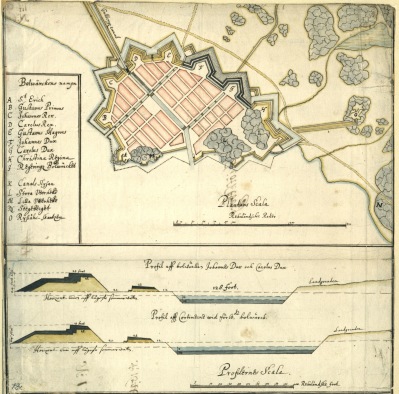 The fort was designed by the General Engineer, Johan Rudberg in 1624 and was constructed from 1624-1643 by Olof Örnehufvud assisted by two engineers, Captain Johan Schultz and a Dutchman Johan Jacobss
The fort was designed by the General Engineer, Johan Rudberg in 1624 and was constructed from 1624-1643 by Olof Örnehufvud assisted by two engineers, Captain Johan Schultz and a Dutchman Johan Jacobss
Hans Månsson in custody of the crown, is taken from court to Gothenburg.
Since the Calmare Nyckel´s two ships had not returned to Gothenburg yet, they were forced to wait, incarcerated in the yet to be completed fort (1624-1643).
The month of June passed at the fort when they found out that it was actually the cargo ship, Charitas that would be transporting the prisoners and the Calmare Nyckel was for the colonists and indentured servants going to New Sweden!
On the ship Calmare Nyckel, was Måns Nilsson Kling. He was of Finnish-Swedish descent and went to Småland where he bacame a soldier and was in Adolf Hårds regiment inJönköping. Kling left the regiment as an officer around 1636.
1637 The first expedition to the future colony of New Sweden was led by Peter Minuit and Kling, now a lieutenant went with them. The expedition set sail on the ships Kalmar Nyckel and Fågel Grip from Gothenburg in late November and arrived in March 1638. Upon arrival, Kling surveyed the area around the landing site and parts of the Delaware River. He went on to become the first governor of the colony.
After his time as governor was finished, Kling was given a mission to return to Sweden to recruit new colonists. He left New Sweden in May 1640 on the ship Kalmar Nyckel and arrived in Sweden in June.
Klings recruiting efforts in the wooded counties gave little result. Therefore the government ordered the governors of Värmland,Närke and Dalarna counties to arrest homeless Finns living in the woods and send them to Gothenburg. Kling left Stockholm on 3 May on the ship Charitas for Gothenburg before setting off on another expedition to New Sweden.
Eventually 50 future colonists who were overwhelmingly Finnish departed from Gothenburg harbor aboard the vessels Kalmar Nyckel and Charitas in July 1641 led by Kling. Kling was accompanied by his wife, small child and a servant.
Beginning 1 May 1641 Kling was appointed Commander of Fort Christina with a monthly salary of 40 riksdaler. In March 1644, Johan Papegoja replaced Kling as Commander of Fort Christina and Kling became Commander of Fort Nya Korsholm which was on an island in the Schuylkill River in the northern part of the colony.
In 1648 Kling returned to Sweden aboard the ship Svanen. He arrived in Stockholm on 3 July and handed over the administrative books to the New Sweden Company’s accountant, Hans Kramer.
Kling is thought to have lived outside of Nyslott (Savonlinna in Finnish) in Säminge ( Sääminki) in what is now Finland. Later he moved to Libeltis ( Liperi) in eastern Finland where he died in 1657.
Hans Månsson trailed with the 4th voyage to New Sweden.
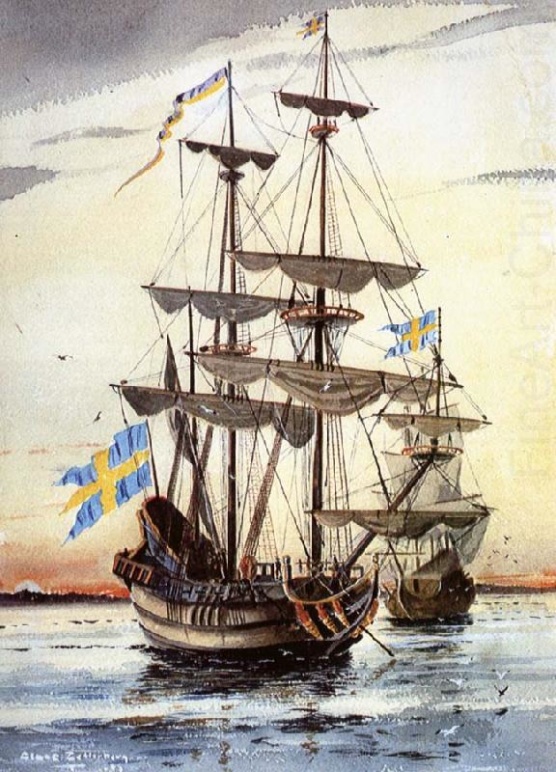
The captain of the Charitas was Jan Jochimsen from Kapell, Schlewig-Holstein, Germany. The voyage would be called the 4th expedition to New Sweden with the Kalmar Nyckel and Charitas, departing in July 1641 and arriving November 1641.
The Kalmar Nyckel* or Calmare Nyckel, was a cargo and warship that was built in Holland around 1625 and in 1628 she was in Swedish possession. The Kalmar Nyckel was one of two ships that carried the bulk of Swedish colonists to New Sweden. The ship at that time belonged to the Söderkompaniet.
On board the Kalmar Nyckel was a person who would play a very important role in the future of the colony - Olof Stille and his family, among them was his daughter Ella age 7 who would later enter her se-
cond marriage as the wife of Hans Månsson.
.
*The ship Kalmar Nyckel was almost unique for its time to have completed four transatlantic voyages. At the time, the ship was part of the Swedish Navy but was later sold back to the Dutch in 1651. On 12 July 1652, the ship sank off the eastern coast of Scotland after a major battle at sea between England and Holland
Brief facts about Nya Sverige/New Sweden
Hans Månsson arrives in New Sweden - Nya Sverige and sets foot in a young colony in Fort Christina
New Sweden was a Swedish Colony founded in 1638.
The colony was situated on the east coast of North America and stretched in to the states of modern day Delaware, Pennsylvania, New Jersey and Maryland.
Last Governor: Johan Risingh
Today belongs to: The United States
Capital: Fort Christina
Ceased to exist as a Swedish colony: 1655- Sweden lost the colony to the Dutch during the Peach Tree war.
Last Regent: Queen Christina and Charles Gustav X.
Below is a list of different forts in the colony and the present day location:
Fort Christina (Fort Kristina) built 1638, Wilmington, Delaware
Fort Nya Elfsborg (Nya Älvsborg) built 1643, Salem, New Jersey
Fort Nya Göteborg (Nya Gotheborg, Tenakung) built 1643, Essington, Pennsylvania
Fort Nya Korsholm (Manäyungh) built 1647, Southwest Philadelphia
Fort Trefaldighet (Trefadlighetsskansen) conquered 1651, New Castle, Delaware
Settlements of New Sweden and present day location:
1641: Finland (Chamassungh) Marcus Hook, Delaware County, Pennsylvania
Upland (Mecoponacka), Chester, Pennsylvania
1642: Sveaborg, Swedesboro, New Jersey
Nya Stockholm, Bridgeport, New Jersey
1643: Minquas or Minquas Island, Southwest Philadelphia, Pennsylvania
Provins (Manaiping) Philadelphia, Pennsylvania
Printztorp (Printzhof) Essington, Pennsylvania, Tequirassy, Eddystone, Delaware County, Pennsylvania
Tinicum, Tinicum, Delaware County, Pennsylvania
1644: Nya Vaasa, Kingessing section of Southwest Philadelphia, Pennsylvania
1645: Mölndal, Yeadon, Delaware County, Pennsylvania
1647: Torne, (Aronameck) Kingsessing section of West Philadelphia, Pennsylvania
1648: Beeversrede, Philadelphia, Pennsylvania
1654: Ammansland, Darby, Delaware County, Pennsylvania; Sidoland, Strandviken, Timber Island and
Översidolandet, Wilmington, Delaware. From Wikipedia
The territory of the colony was about 192 miles, stretching close to modern day Trenton in the northwest, near modern day Chesapeake Bay to the southwest, to the east near modern day Atlantic City and modern day Harrisburg to the west.
During a visit to Holland in 1635 the Chancellor of Sweden, Axel Oxentierna met Samuel Blommaert, a merchant, Peter Spiring, a Dutchman who was in the service of Sweden and Peter minuit, a German, who had been the governor of “New Netherlands” a Dutch colony of the Dutch West India Company. These men drew up plans for an eventual Swedish colony and in the beginning of 1637, Peter Minuit came to Sweden to present a proposal for the founding of a colony by the Delaware River in North America.
After the government gave its approval, capital was raised. Half came from Sweden and half from Holland after which a trading company was founded called the Söderkompaniet ( Later the New Sweden Company). The main purpose of the company was to import tobacco and leather to Sweden.
Two ships, the Kalmar Nyckel and the Fågel Grip, with a crew made up of Dutch and Swedes, left Gothenburg´s port in November 1637 with Peter Peter Minuit in command. In March of the following year, the ships arrived in Delaware Bay. Minuit began negotiating with the Indians to buy land which included a stretch of the riverbank to the right of the mouth of the river to the Schuykill tributary but without any inland boundary provisions. At the center of the future colony, Minuit constructed an entrenchment with a few wood houses and named it Fort Christina in honor of the reigning queen of Sweden, Christina.
Founder and Governor Peter Minuit 1638 - left the same year
After Peter Minuit established relations in the little colony, he turned control of the colony over to Lieutenant Måns Nilsson Kling and set off back to Europe to submit a report.
Unfortunately, Minuit died on board a Dutch ship making a stop at the island of St. Christopher in the West Indies 1638. The ship was swept out to sea and was never found. However, both of the Swedish ships continued the voyage back home to Sweden.
The Dutch partners in the company were eventually bought out and the government in Sweden forced fugitive knaves and convicts to emigrate to New Sweden.
An own 'box' about Peter Minuit - Founder of New Sweden in 1638 - also bought Manhattan in today's New York!
 The Tulip tree (liriodendron tulipifera), where the purchase of Manhattan is said took place grew to a height of 165 feet and a girth of 20 feet. It was, until its death in 1932 at the age of 220 year
The Tulip tree (liriodendron tulipifera), where the purchase of Manhattan is said took place grew to a height of 165 feet and a girth of 20 feet. It was, until its death in 1932 at the age of 220 year
*Peter Minuit (borned between 1580 and 1585 – dead August 5, 1638) was a Walloon from Tournai, in present-day Belgium. He was the 3rd Director of the Dutch North American colony of New Netherland from 1626 until 1631, and 3rd Governor of New Netherland. He founded the Swedish colony of New Sweden on the Delaware Peninsula in 1638.
Minuit is generally credited with orchestrating the purchase of Manhattan Island for the Dutch from the Lenape Native Americans. Manhattan later became the site of the Dutch city of New Amsterdam, and the borough of Manhattan of modern-day New York City. A common account states that Minuit purchased Manhattan for $24 worth of trinkets. A letter written by Dutch merchant Peter Schaghen to directors of the Dutch East India Company stated that Manhattan was purchased for "60 guilders worth of trade", an amount worth approximately $1,143 in 2020 dollars.
Biography;
Peter Minuit was born at Wesel between 1580 and 1585 into a Calvinist family[5] that had moved from the city of Tournai (presently part of Wallonia, Belgium) in the Southern Netherlands, to Wesel in Germany, in order to avoid Spanish Catholic colonials, who were not favorably disposed toward Protestants. His surname means "midnight" in French.
His father, Johann, died in 1609 and Peter took over management of the household and his father's business. Peter had a good reputation in Wesel, attested by the fact that he was several times appointed a guardian. He also assisted the poor during the Spanish occupation of 1614–1619.
Minuit married Gertrude Raedts on August 20, 1613. Gertrude was from a wealthy family and she probably helped Peter Minuit establish himself as a broker. A will drawn up in 1615 in the Dutch city of Utrecht, mentions "Peter Minnewit" as a diamond cutter.[6] Whether he traded in other items is unknown.
By 1624, the city was in an economic decline and in 1625, he had left Wesel and like others, went to Holland. At first, Gertrude went to stay with her relatives in Cleve.
As director of New Netherland;
Minuit joined the Dutch West India Company, probably in the mid-1620s, and was sent with his family to New Netherland in 1625 to search for tradable goods other than the animal pelts that then were the major product coming from New Netherland. He returned in the same year, and in 1626 was appointed the new director of New Netherland, taking over from Willem Verhulst. He sailed to North America and arrived in the colony on May 4, 1626.
Minuit is credited with purchasing the island of Manhattan from the Native Americans in exchange for traded goods valued at 60 guilders. According to the writer Nathaniel Benchley, Minuit conducted the transaction with Seyseys, chief of the Canarsees, who were only too happy to accept valuable merchandise in exchange for an island that was mostly controlled by the Weckquaesgeeks.
The figure of 60 guilders comes from a letter by a representative of the Dutch States-General and member of the board of the Dutch West India Company, Pieter Janszoon Schagen, to the States-General in November 1626. In 1846, New York historian John Romeyn Brodhead converted the figure of Fl 60 (or 60 guilders) to US$23. The popular account rounds this off to $24. By 2006 sixty guilders in 1626 was worth approximately $1,000 in current dollars, according to the Institute for Social History of Amsterdam.
According to researchers at the National Library of the Netherlands, "The original inhabitants of the area were unfamiliar with the European notions and definitions of ownership rights. For the Indians, water, air and land could not be traded. Such exchanges would also be difficult in practical terms because many groups migrated between their summer and winter quarters. It can be concluded that both parties probably went home with totally different interpretations of the sales agreement."
A contemporary purchase of rights in nearby Staten Island, to which Minuit also was party, involved duffel cloth, iron kettles, axe heads, hoes, wampum, drilling awls, "Jew's harps", and "diverse other wares". "If similar trade goods were involved in the Manhattan arrangement", Burrows and Wallace surmise, "then the Dutch were engaged in high-end technology transfer, handing over equipment of enormous usefulness in tasks ranging from clearing land to drilling wampum."
Minuit conducted politics in a measure of democracy in the colony during his time in New Netherland. He was highest judge in the colony, but in both civil and criminal affairs he was assisted by a council of five colonists. This advisory body would advise the director and jointly with him would develop, administer, and adjudicate a body of laws to help govern the colony. In addition there was a schout-fiscal, half-sheriff, half-attorney-general, and the customs officer.
During Minuit's administration, several mills were built, trade grew exponentially, and the population grew to almost 300. In 1631, the Dutch West India Company (WIC) suspended Minuit from his post for reasons that are unclear, but probably for (perhaps unintentionally) abetting the landowning patroons who were engaging in illegal fur trade and otherwise enriching themselves against the interests and orders of the West India Company.
He arrived back in Europe in August 1632 to explain his actions, but was dismissed and was succeeded as director by Wouter van Twiller. It is possible that Minuit had become the victim of the internal disputes over the rights that the board of directors had given to the patroons.
Establishing the New Sweden colony;
After having lived in Cleves, Germany for several years, Minuit made arrangements with Samuel Blommaert and the Swedish government in 1636 or 1637 to create the first Swedish colony in the New World. Located on the lower Delaware River within territory earlier claimed by the Dutch, it was called New Sweden.
Minuit and his company arrived on the Fogel Grip and Kalmar Nyckel at Swedes' Landing (now Wilmington, Delaware), in the spring of 1638. They constructed Fort Christina later that year, then returned to Stockholm for a second load of colonists, and made a side trip to the Caribbean on the return to pick up a shipment of tobacco for resale in Europe to make the voyage profitable. During this voyage, Minuit drowned when the ship he was visiting (at the invitation of its Dutch captain, a friend of Minuit), The Flying Deer, was lost with all hands during a hurricane at St. Christopher (today's St. Kitts) in the Caribbean. The losses suffered, such as goods, colonists, and Minuit, caused irreversible damage to Sweden's colonization attempts.
Two years later, Swedish Lt. Måns Nilsson Kling, whose rank was raised to captain, replaced him as governor. Nine expeditions to the colony were carried out before the Dutch captured it in 1655.
Places named after Minuit;
The Staten Island Ferry Whitehall Terminal's Peter Minuit Plaza, north of the South Ferry – Whitehall Street station (1, N, R, and W trains). Following the 400th anniversary celebrations of Henry Hudson's voyage to Manhattan, a pavilion was opened there to honor the Dutch. Each night at midnight, LED lights around the pavilion's perimeter glow in honor of Minuit.
A marker in Inwood Hill Park at the supposed site of the purchase of Manhattan
A granite flagstaff base in Battery Park, which depicts the historic purchase
A school and playground in East Harlem, which are named for him.
An apartment building at 25 Claremont Avenue in Manhattan, which bears his name above the front entrance
From Wikipedia
1641 Hans Månsson comes with 4th voyage to Fort Christina
With 20 soldiers, an interpreter and a commissioner, New Sweden had the character of a trading post for the first two years. More than likely there was not much excitement in the colony and very boring while waiting in anticipation for the next ship to arrive from Sweden. Not until the spring of 1640 did a ship return from Sweden and with it a new governor, Peter Holländer Ridder. Ridder bought more land from the Indians.
The following year, 1641 Måns Nilsson Kling retuned with the Calmare Nyckel and was now the commander-in-chief of Fort Christina. Hans Månsson also disembarked from the sister ship Charitas.
Governor Johan Printz 1643 - 1653
In February 1643 the next expedition arrived in New Sweden with a new governor, Johan Printz on board. He was a goal oriented and dedicated man and he built up the colony both in size and financially. He established more entrenchments and blockhouses with Nya Elfsborg, Nya Göteborg, Nya Vasa, Mölndal and Upland being examples of this. He also built a few more forts and trading posts.
With the land purchases made by Minuit, Ridder and Printz, New Sweden now covered the entire western part of Delaware from Cape Henlopen on the coast up to what is today, Trenton, as well as the eastern part including the area around Nya Elfsborg among other places totaling 20 swedish miles ( 1 Swedish Mile = 10km. 200km = 124 Imperial miles) long.
However, the number of Swedish and Finnish colonists were not enough to colonize the entire area and the settlements were too spread out. It proved difficult to maintain the colony from Sweden with supplies and when the Swedish ship “Kattan” sank, things turned bad for the Swedish colony.
The Dutch governor, Peter Stuyvesant was gaining more power both economically and militarily. When the colonists mutinied Printz because they thought he ruled too harshly, he gave up and returned home. Before he left, he named his son-in-law as his substitute as governor. In spite of the tensions between Printz and the colonists, his years as governor (1643-1653) marked the glory days of the colony.
Still, the colony turned on Printz and greatly weakened his standing. There were six convicts whose court sentences had elapsed in 1647 and were now freemen, Hans Månsson, was one of these freemen and he signed the protest petition against Governor Johan Printz in 1653.
The fate of the colony - finally taken over hostilely by the Dutch in 1655
The number of expeditions to New Sweden totaled 11. The last expedition arrived shortly after the Dutch took over the colony. The fact that the colony was no longer Swedish didn’t stop the many Swedes who wanted to emigrate there.
As late as 1664 a ship arrived with Finnish families from Medelpad and Swedish priests were sent between 1696-1783 to administer the parishes that the colonists established. Among the priests who came, was Johannes JonÆ Holmiensis Campanius. He was the garrison chaplain at Fort Nya Göteborg as well a missionary to the Indians. Swedish priests were continually sent to New Sweden until the population no longer understood the Swedish language.
Swedes and Finns assimilated but Swedish was spoken up until the end of the 1700´s. By the turn of the century there were 1,200 Swedes and Finns. Cultural ties with Sweden remained strong with Swedish priests and bibles being sent to the colony until 1783.
Watch archive film from the Crown Prince's visit to Wilmington in 1938 (2 minutes into the film):
www.filmarkivet.se
See also critical voices in today's world to celebrate Sweden's Colonialization of the indigenous people! As for example from Folket i Bild 2013: Please read the article here; Folket i Bilds arkiv
Distasteful celebration of Sweden's colonial history in North America
Antonie Frank Grahamsdaughter 17 maj 2013
King Carl XVI Gustaf and Queen Silvia visited Wilmington. They were on site to celebrate Sweden's colony "New Sweden" in the state of Delaware, North America, which turns 375 years old. The royal couple and the Swedish ambassador to the United States participated in the celebration and the festivities organized by the Swedish-American organization The Swedish Colonial Society. The Festivals were attended by Oscars Borg Lodge # 172 and Vaasa Order of America.
"Even today, the indigenous peoples of North America live off the suites of colonization. Many live in very severe poverty, substance abuse problems and where suicides can be as high as 4 out of 10. We can only hope that the King of Sweden captures his senses and in the future refrains from celebrating the formation of the colony "New Sweden" in North America. "
Hans Månssons life and fate 1641-1691
After serving his sentence of indentured servitude in New Sweden, Hans Månsson became a freeman in 1647 and settled in Aronameck in Kingsessing. In 1653, he was one of the freemen who signed the protest petition against Governor Johan Printz.
1654 Hans married his best friends wife, Ella Jochimsson, two years after her husband Peter died. Ella Stille was 20 years old and the daughter of Olaf Stille (1610-1684) who had arrived in New Sweden at the same time as Hans in 1641. Ella had two children with Peter Jochimsson; Peter and Elizabeth.
Peter Jochimsson or Jochim (ca. 1618-1654) Arrived in New Sweden aboard the Swan in 1643.
He married Ella Olofsdotter Stille (1634-1718) in ca. 1652. Peter and Hans were close friends.
Ella and Hans Månsson's children change their last name to Steelman after Hans´death in 1691.
Sven Gunnarsson (ca. 1610 - 1679) came to New Sweden as early as 1640. His daughter, Gertrude Svensdotter (ca. 1636-1695) married Jonas Nilsson (1620-1693) ca. 1654. Their daughter, Judith Jinasdotter (1658-1727) married Peter Yocum (1653-1702) ca. 1675 and they had 10 children. Peter Yocum was the son of the aforementioned Peter Jochimsson and Ella Olofsdotter.
Sanford L. Steelman Jr tells in augusti 2018 his 'saga' about Hans Månsson and his life in Amerika
Hans Månsson Saga - Sanford L. Steelman Jr. August 2018
Note! Both the english och swedish version of Sanfords paper is edited by Skarke-Varnhems Hembygdsförening to reduce the content volume of general Swedish history and specific family history for this very branch of the families Steelman.
The actual translation into Swedish is done by Kerstin Lidberg, Skarke-Varnhems Hembygdsförening.
Forward
The Steelmans of North Carolina
All of the North Carolina Steelmans come from one common ancestor, Matthias Steelman, who moved from Murtherkill Hundred, Kent County, Delaware to Surry County, North Carolina, along with his wife, Ruth, and their 10 children.
In 1755, Matthias Steelman of Kent County, Delaware, gave testimony in a Maryland legal dispute in which he stated that he was 27 years of age. This would make his year of birth 1728. It is likely that he was born in Delaware, Maryland, or New Jersey. He first appears in the records of Kent County, Delaware on November 26, 1747, when he obtained a warrant for 100 acres of land. Matthias and Ruth sold their lands in Delaware in 1770, and first appear in the records of Surry County, North Carolina in 1773.
During the Revolutionary War, Matthias and his sons fought on the Patriot side, and Matthias has been recognized by the DAR as a basis for membership in that organization. Matthias’ will was probated in November of 1793.
We have been unable to determine the parents of Matthias, but it has been established that he was a descendant of Hans Mansson, the Swedish settler who came to America in 1641. I am a direct male descendant of Matthias Steelman, and received the following e-mail:
You are a Y-DNA match to a member of the Swedish Colonial Society
(SCS) DNA Project at Family Tree DNA. They are a confirmed descendant of Hans Mansson who is a
Forefather registered at the Swedish Colonial Society.
Based upon this DNA evidence, all descendants of Matthias Steelman are descendants of Hans Mansson, who is the subject of this booklet.
New Sweden
The story of Hans Mansson, and how he came to America were shaped by a series of events that took place in Sweden in the 1500’s and 1600’s.
To start with the king Gustavus daughter after he was killed at the battle of Lutzen in 1632, his last victory. He left as the heir to the throne, his 6 year old daughter, Christina.
Sweden at this time was a major European power, controlling what is now Finland, and much of the lands south of the Gulf of Finland. At this time, many European powers sought to establish colonies in America. Sweden was no exception.
Queen Christina’s government hired Peter Minuit, a Dutchman, to assist it in planting a colony in America. Minuit had previously been involved in the Dutch colony of New Netherlands, purchasing the island of Manhattan from the Indians in 1626.
He selected as the site of the new Swedish colony the “South River” (now known as the Delaware River). Located on the west side of the river, the new settlement was named Fort Christina. The first colonists arrived in 1638. However, the Swedish government had difficulty in convincing its citizens to travel to America.
Hans Månsson från Hanaskede
In 1684, Hans Mansson gave an affidavit to William Penn (founder of the colony of Pennsylvania) stating that he was 72 years of age. This place his year of birth in Sweden around 1612.
In 1640, he was a cavalryman stationed at Hanaskede Manor, the homestead for a rider with horse for the Vastagota Rythare Reigment, outside of the town of Skara. Hans Mansson would have been in Gudhems Company 3. (see insignia of company to the right).
One of his duties was to take care of the horses on the farm, not least his own horse för the cavalry. For this task, he needed combs, and best wood for this and also other agriculture tools was from fruit trees. He found such trees at the abbey at Varnhem, which was the garden of the Crown since the reduction.
***********
Skarke-Varnhem historical society writes;
We really don’t know how it was for the orchard. We can read about the garden when the monks owned it, that it was a beautiful garden as an orchard and for vegetables for the whole monastery.
The Crown’s reduction after the reformation’s decisions in the parliament 1527 led to a new age for Varnhem Monastery. The Crown owned it but let embers of the nobility take responsibility - first also for the monks that could live there for a short while.
The last monk left Varnhem 1540 and other than the Crown managed the garden. We know that the monastery became almost ruins after a while, but we don’t know if the garden went to meet the same fate. 1566 the church and monastery were demolished by the Danish.
But we know that the garden was in a condition worth giving from the Crown to the Skara Hospice as vegetable and fruit tree garden 1689. Probably was it not as beautiful as when the monks gardening it and probably it was dilapidated in some extent.
So we think it was recognizable as garden 1640 - about 100 year after the reduction to the Crown and it was certainly not abounded, and everybody in deed knew that it was a garden of the Crown and with restricted area for others to use.
Hans Månsson's fate is sealed
In the fall of 1640, Hans Mansson was arrested at Hanaskede and charged with chopping down six apple trees and two cherry trees at Varnhem Abbey. This horrible crime was brought to the attention of Queen Christina and her council. In a letter dated April 13, 1641 to the Governor of Skaraborgs Lan, the Queen stated:
“Inasmuch as we find this to be a much bigger and heinous crime than if he had broken into some man’s coffers and other property and there stolen some goods, for that reason Our Royal Pleasure and Command is that you shall bring him without delay to court to be condemned according to his crime, afterwards leaving to his discretion whether he should sail with wife and children* on our ship from Gothenburg to New Sweden, or hang; if he chooses the voyage to the said New Sweden, then you could tell him that when he has been there for six years he will be pardoned. But if he does not, you may execute the sentence and let him hang according to his deserts; yet you must keep all this secret and not let him know those conditions before the sentence is passed.”
On May 31, 1641, in what was clearly nothing more than a show trial. Hans Mansson was found guilty by the court and was sentenced to be hanged or go to New Sweden with his wife and family. The trial record states that “he chose the voyage and was consequently imprisoned in order to be taken to Gothenburg.”
It should be noted that in the 1600’s the penalty for most crimes was either death or mutilation. While based upon our standards of justice, Hans Mansson was clearly mistreated by the Queen and the courts of Sweden, it is fortunate for the Steelman family that he chose the second option, and came to America.
Two ships, the Kalmar Nyckel and the Charitas set sail from Gothenburg, Sweden, and arrived at Fort Christina on November 7, 1641.
* There are no other sources than the Queens letter
* There are no other sources than the queen's letter which says that Hans Månsson had married and had children before he was transported to New Sweden in 1641. Nor is there any information in the documentation about the crossing that wife and children were included. New Sweden also sees no documents about a first family, despite rigor research. The expression in the letter was probably added to ensure that the rider would be allowed to take the family with him if he had one.
Hans Månssons first time in Amerika
In 1644, Hans Mansson was a laborer planting tobacco at Upland. By 1648, having served his six-year sentence, he was a freeman living in the colony.
On February 15, 1643, two ships, the Fawn and the Swan arrived at Fort Christina, bearing the new governor of the colony of New Sweden, Johan Printz. Printz was a huge man, nearly seven feet tall and weighing over 400 pounds. He was referred to as “Big Belly” by the Indians. At the ceremonies marking the 300th Anniversary of the founding of New Sweden in 1938, President Franklin D. Roosevelt quipped:
“There never was a Governor, before or since, that weighed as much as Johan Printz.”
Unfortunately for the colonists, Printz was not a jolly old soul, but an autocratic administrator. On July 27, 1653, Hans Mansson was one of 22 settlers who signed a petition protesting Printz’ oppressive rule. Printz promptly had the ringleader of the protestors, Anders Jonsson hung on August 1, 1653. Shortly thereafter, Printz was recalled to Sweden, and left the colony in 1654. The last governor of New Sweden was Johan Rising, who was to make extensive use of Hans Mansson in 1654 and 1655.
On June 7, 1654, Hans was sent by Governor Rising to Maryland to try and convince deserters from New Sweden to return to the colony. He returned on June 15, 1654, having no success, but advised that a delegation of Maryland officials was en route.
The Dutch in New Amsterdam (now New York City) were never happy with a Swedish colony on the “South River”. They were viewed as competitors for the lucrative Indian trade. In July, word came from New Amsterdam that Governor Rising’s emissary to the Dutch, Peter Jochim, had died. Peter was a German soldier and friend of Hans Mansson. He was married to Ella Stille, and had a son, also named Peter Jochim. Hans volunteered to go to New Amsterdam on July 27, 1654 and determine what the Dutch were up to. He returned on August 12, 1654, reporting that Dutch Governor Peter Stuyvesant was awaiting orders to come to the South River, and clear out the Swedes.
The relations between the Swedes and the Dutch continued to deteriorate, in part because Governor Rising had ejected the Dutch from New Sweden, and seized a Dutch fort located on the east bank of the South River.
In August of 1655, Governor Rising sent Hans Mansson and Jacob Sprint to Staten Island to spy upon the Dutch. They returned with information that Stuyvesant was preparing to invade the South River with a flotilla of ships and many soldiers.
On August 31, 1655, Hans volunteered to go to the defense of Fort Christina. Faced with overwhelming military force, and knowing that no help would come from Sweden, Governor Rising surrendered the Swedish forts along the South River to the Dutch.
New Sweden was formally incorporated into New Netherland on September 15, 1655. The Swedish settlers were allowed considerable local autonomy, retaining their own militia, religion, courts, and lands. Dutch rule only lasted for 9 years. By October 1664, both New Netherland and the forts on the South River were captured by the English. The lands that had been New Sweden became part of the English colonies of Pennsylvania and Delaware.
Hans Månsson life adter the marriage 1854
Hans Mansson’s life changed dramatically in 1654, when he married Ella Stille, the widow of Peter Jochim.
He moved to Aronameck plantation, where the Jochims had lived, on the south bank of the Schuylkill River.
On May 14, 1669, Hans Mansson received a patent for several tracts of land, including Aronameck, which was estimated to contain 100 acres. When the property was eventually surveyed in 1675, it was found to contain 1100 acres. Quite a discrepancy!
It is my belief that Aronameck belonged to the Jochim family, and when Peter Peterson Jochim came of age, the property was conveyed to him. Aronameck was subsequently acquired by botanist William Bartram in the late 1700’s. The site of Hans Mansson’s home is now part of Bartram Gardens in South Philadelphia. This is a beautiful 45 acre preserve located on the south bank of the Schuylkill River. Portions of the house may date to the time of Hans Mansson.
Hans Månsson became captain 1672
In 1672, Hans Mansson became captain, and commanding officer, of the militia. As a central place of defense, a blockhouse was built at Wicaco which also served as the Lutheran Church for the up-river Swedes from 1677 until construction of Gloria Dei Church in 1700.
Wicaco was the Indian name of the settlement north of the Schuylkill River. From that point forward, he was known as Captain Hans Mansson. We know that settlement today by the name given to it by William Penn; Philadelphia.
When Penn arrived in America in 1682, Hans Mansson and the Swedes had been there for 40 years! We know from a letter written by William Penn to Hans’ son, John Hanson Steelman, that Penn knew Hans Mansson.
*The Wicaco Church
'In 1693, the log church at Wicaco served Swedish families lining the Delaware River and its tributaries from Neshaminy and Senamensing on the north to Marcus Hook and Oldman's Creek on the south.
On the west side of the Delaware, all Wicaco church members lived below the fall line of the navigable streams. It would be several years before the first Swedish families ventured above that fall line to settle in new Swedish tracts granted by William Penn at Matsunk (present Upper Merion township in Montgomery County, Pennsylvania) and
Manatawny (present Amity township in
Berks County).
The largest concentration of Swedes west of the river was between the towns of Philadelphia and Chester (former Upland), extending from Wicaco to Ridley Creek (formerly Olof Stille's Creek) and encompassing Moyamensing, Passyunk, Nitapkung, Aronameck, Kingsessing (including Carkoens Hook at its western end), Cocks Island, Boons Island, Calcon Hook and Ammansland. Tinicum Island, the place of government under Governor Johan Printz (1643-1653), was in English ownership in 1693.
East of the Delaware the principal concentration of Swedes attending the Wicaco church lived in the area from Mantua Creek to Raccoon Creek. A smaller group resided near the mouth of Pennsauken Creek in areas know as Senamensing and Putshack.
Most of the place-names were derived from Indian names or phrases, although many had Swedish origins, as is obvious with Upland (Uppland), Finland and New Stockholm. Boons Island, Cock's Island and Cobbs Creek were named after families belonging to the Wicaco church. Crum Creek was derived from the Swedish word for 'crooked' (krum).
Source: The 1693 Census of the Swedes on the Delaware by Dr. Peters Stebbins Craig, p. 10.
Read more about Wicaco on this page; Historic Gloria Dei (Old Swedes') Preservation Corporation, HGDPC
The Family Hansson moves across the Delaware to New Jersey 1681
In February 1674, Hans Mansson obtained a permit to settle land across the Delaware River in West Jersey. At that time, New Jersey was divided into two colonies, East Jersey and West Jersey. It does not appear that Hans immediately moved across the river, but waited several years before moving his entire family (other than Peter Jochim) to the east side of the river.
He continued to serve as militia Captain. On November 13, 1677, Hans Mansson, along with Peter Jochim and Jan Stille petitioned the Upland Court that a town be formed on the west side of the river, below the falls. It is not clear whether they were referring to the Delaware River or the Schuylkill River.
On November 12, 1678, the Upland Court found that it was necessary for a mill to be built on the Schuylkill River, and that there was “no fitter place” than the fall called Captain Hans Mansson’s fall. Captain Hans agreed to the construction of the mill. This would support the conclusion that the 1677 request was for a town on the Schuylkill River.
The records of the court at Burlington, West Jersey on August 3, 1680, show Captain Hans Mansson to be a freeholder.
On April 29, 1681, Hans Mansson deeded to Peter Jochim the 1100-acre tract on the west side of the Schuylkill River (Aronameck Plantation). Thus, by 1680-81, we can assume that Hans and his family had moved across the river.
On August 24, 1682, 500 acres in New Jersey were surveyed for Hans Mansson and Frederick Frederickson, next to the river. The deed for this property was recorded on February 12, 1684.
On April 10, 1688, Hans Mansson, described as a planter of Senamensinck, Burlington County, received a patent for 100 acres from William Biddle..
Hans Månsson dies 1691 and his widow Ella Stille (Steelman) dies 1718
On May 10, 1692 the Widow Hance was shown in the town meeting book for Chester Township, Burlington County, New Jersey, rated for taxes. This would indicate that Captain Hans Mansson died over the winter of 1691-1692.
Andreas Rudman was the pastor of Gloria Dei Church in Philadelphia (Old Swedes Church) from 1697 to 1708. In 1697, he prepared a list of the parishioners of Gloria Dei Church, which included members on the east side of the Delaware River.
Included in this list is the following entry: "Mrs. Ella, mother of the Steelmans now. Her sons: Eric, aged 16 ys.; Charles, 18 ys." This is the first known usage of the name Steelman in the records of the Delaware Valley. The word “now” indicates that there has been a change in the name of the family. The entry referred to “Mrs. Ella” who was Ella Stille who married Hans Mansson, and to their two youngest sons, Eric and Charles.
A deed recorded in Deed Book DD at page 206 of Burlington County, New Jersey provides clear confirmation that Hans Mansson was the father of the Steelmans:
"A deed made 25 May 1730 by Charles Steelman of the County of New Castle on Delaware, son and heir of Charles Steelman, late of Sinsminson, Burlington County, New Jersey deceased, by and with advice and consent of John Bird of New Castle and Margaret, his wife, and of David Enuxen and Eleanor his wife of the same County, sisters of the aforesaid Charles Steelman, sells to Philip Waller of Evesham in Burlington County for £ 30.00 a small tract of land in Chester Township on the east side of Peniscukin Creek. The land was purchased of William Biddle by Hance Monsier, grandfather of the said Charles Steelman, by deed of 10 April 1688 and sometime after, was bequeathed by Hance Monsier to Charles Steelman, father of the grantor, Party to this Present, by the last will and testament of ye P. Haunce Monsiere, as will be ye Present will, recourse being etc."
Unfortunately, the will referenced in this deed has never been found. What a treasure that would be! Note that the name Mansson is found in many variant spellings in the records of New Sweden, Pennsylvania and New Jersey.
The widow of Hans Mansson, Ella Stille, was buried at the “Old Swedes” Church in Swedesboro, Gloucester County, New Jersey on January 22, 1718. There are no marked graves in the oldest sections of the cemetery. It is likely that Hans Mansson was also buried there.
You can download the un-edited version here of Sanford L. Steelman Jr where tells his 'saga' in august 2018 about Hans Månsson and his life in Amerika;
Hans & Ella became the forefathers of a family that is still growing strong well after the era of New Sweden. This is just the beginning of their family tree.
The family tree below is based on an article by James F. Steelman in “The Atlantic County Historical Society’s Yearbook” 2000 - sent to us from Mary Ann Royal.
Hans Månsson (Mansson) and Ella Olofsdotter Stille were parents of six sons Hansson.
John, Jöns or James, Christiern (Not listed in the 1693 census) , as well as Peter, Charles and Eric.
All of the Hansson boys took the surname of Stillman, by combining the first part of their mothers maiden name and the first part of their fathers surname. (Man/Mån) Still+Man was soon Americanized to Steelman.
Formalaties for some of the first Generations;
Hans Månsson's, born 1612, - parents Måns Hansson & Brita Lilliebielke (she died 1612) - died 1691
Ella born Stille 1634 - Olof Stille was her father (She was 22 years younger than Hans) - died 1718
Their children;
1. Johan Hansson (later; John Hans Steelman) born 1655 in Aronameck, New Sweden - died 1749
- married to Maria Stalcop, daughter of Johan (John) Andersson Stalcop and Christine Carlsdotter
children with Maria; Johan Hans Steelman Jr
Måns Hans Steelman
2. Jöns Hannson (later; James Steelman) born probably in Aronameck - died 1734
- married to Susannah Toy born 1690 - died 1708 -He lived in adultery with Brita Fish, wife of Gustavus Fish & sentenced 1710
- license for second marriage dated 13 June 1708 to Katherine Ouster
children with Susanna; Andres (Andrew) Steelman, born; 1691 Senamensing, Burlington
County, West Jersey - died 1736
- married to Judith Alison 1738 - died 1751
Susannah Steelman, born 1693 i Sensamensing Burlington County, West Jersey
- died 1753
- Married 1713 to John Keen, born 1695 - died1758
Haunce (Hans, Hance) Steelman, born after 1697 - died 1761
- married to Sarah
John Steelmann, born before 1702 - died 1762
James Steelman (Jr), born before 1706 - died 1785
- married to Katherine Jones (Swedish) before 1742
children; Peter (Lilttle Peter) Steelman born 1733 - died 1775
Elias Steelman, born before 1708 in Great Eggharbour, Glochester County, W.
N. Jersey - died 1739
- married 1730 first time and 1732 for the second time
Maria (Mary) Steelman, born before 1708 - died before 1785
- married the first time 1728 to Daniel Allen and the second time 1733 to
Andrew Blackman
3. Christiern Hansson* (later Christiern Steelman) - died after 1737 New Castle County; Delaware
- married to Mary (Cann) Claypoole - widow and a daughter of John och Mary Cann - 1709 he resided i New Castle County
4. Peter Hansson, (later Peter Steelman) i Senamensing 1674 - died after 1737 i Gloucester C. W.N.Y.
- married to Gertrude (Gartara) Hansdotter Keen - d. of Hans Jürgensson & Williamke (Kühn) Keen
children with Gertrude; Matthias Steelman, born 1700 - died 1784
- married 1730 to Sarah Adams - died 1791
- daughter of Jonathan & Barbara Adams
Gartara Steelman, married 1730 to Daniel Lake
George Steelman, born 1712
- married 1737 to Phebe Adams, daughter of Jonathan Adams och Barbara
Peter Steelman, born 1720 - died 1720
Maria Steelman, born 1720
Charles Steelman - died 1779
- marriage 1 ( as Charles Stellman) 1731 with Margaret Scull - died 1739 -
daughter of Peter Scull
- marriage 2 to Mary Adams
5. Charles Hansson, (later; Charles Steelman Sr) born in Senamensing 1679 - died 1708 i Sensaming
- married 1694 to Anna Antonsdotter Nilsson born in July 1676 - daughter of Anthony Nilsson (alias; 'Long, a swede')
children with Anna; Charles Steelman Jr
- married 1737 Johanna Lowell at Holy Trinity Church in Cristina, Delaware
Margaret Steelman
- married to John Bird - son of Thomas Bird and his wife Sarah Epson - Both
English
Eleonor Steelman
- married to David Enochson -son of Garret and Gertrude Enochson - Both
Swedish
6. Eric Hansson, (later; Eric Steelman) born 1681 i Senamensing, New Sweden - died 1731 of smallpox
- married 1701 to Brita (Birgitta) - died 1726
children with Birgitta; Haunce (Hance, Hans) Steelman, born 1702 - died 1760
- married to Alice Jones born 1694 - died 1767 - daughter of the widowed
Catherine Jones
Carl (Charles) Steelman, born 1724 - died 1784
- marriage 1 1756 to Brita Dahlbow
- marriage 2 (as Charles Stillman) to Mary (Maria) Forbes, born 1741
- Hugh Forbes´widdow.
James Steelman
- marriage 2 to Rebecca Jones Boles
Brigit (Birgitta) Steelman, born 1726 - died 1726
Mary Steelman
- marriage 1 1735 to Elias Champion
- marriage 2 2 1751 to Joshua Belague (Bellenger)
Eric Steelman -died before 1718
Catherine Steelman
Hans Månsson was a respected leader. He succeeded Sven Skute as captain of the militia and served as spokesman for the settlers in the area. He was also a translator for the Indians in the area. After Hans died in 1691 the family changed their names to Stillman - soon Steelman. They all did very well in America. There are two towns in New Jersey named after the Steelmans.
Hans Månsson was the first settler at Pennsauken Creek by “Senamensing” (Now Kanelinson, NJ).
On May 14 1669, Hans Månsson received from the English, a deed for Aronameck plantation . The plantation covered 1,100 hektar( 2,718 acres) and stretched from the Schuykill River to Cobbs Creek in Kingsessing.
After moving to New Jersey, he sold the land to his stepson, Peter Petersson Yocum.
Hans Månsson had a 500 acre strip of land in New Jersey that was allowed by a license issued in 1674. It was located on the north side of Pennsauken Creek and was shared with Jonas Keen and Fredrick König or King. A deed was finally issued on 23 February, 1683/4.
Hans squired an additional 100 hektar (247 acres) on 1 April 1688. He died about 1691. On 10 May, 1692 his window inherits the estate and soon after she and her sons change their last name to Steelman.
Source: 1693 census of Swedes in Delaware by Dr. Peter Stebbins Craig, p.60
Hans and Ella´s son, Christiern Steelman, left home in 1693 but where he went at that time is unknown. He resided in New Castle county in 1709 and had married Mary, widow (her husband James Claypoole Jr, died in 1706) and daughter of John and Mary Cann, Quakers who arrived in Griffin, West Jersey in 1675. It’s not known if Christiern had any children, but up to 1737 was an active member of Holy Trinity Church, where he often stood as a witness for baptisms.
Mary Ann Royal and her connection to Hans Månsson*
Hans Månsson & Ella Olofsdotter Stille
(1612 - 1691) (1634 - 1718)
Jöns Steelman** & Susannah Toy
(1670 - 1734) (1690 - 1708)
John Steelman & Unknown
(1702 - 1762)
John Steelman & Abigail Adams
(1730 - 1796) (1726 - )
Abigail Steelman & Richard Higbee
(1758 - 1812) (1753 - 1825)
Daniel Higbee & Abigail Bowen
(1790 - 1845) (unknown)
Amasa Higbee & Eliza Holman
(1822 - 1900) (1823 - 1900)
Annie Eliza Higbee & Gilbert Moses Van Sant
(1855 - 1922) (1854 - 1921)
Cornelia Higbee Van Sant & Silas Ingemar Royal
(1887 - 1976) (1887 - 1944)
Frank Robert Royal & Julia Veronica Stasulis
(1917 - 1998) (1916 - 1997)
Mary Anne Royal*
(1944 - Present) *Presented of Mary Anne Royal
*Mary Ann Royal has passion for social and environmental justice. Her career as an early childhood educator and then elementary school counselor gave her insight into the boundless potential that exists in everyone. Helping children and families overcome barriers placed in their way, sometimes by the very educational system that was supposed to help them realize their potential, was her life's work.
Little Earth, a K-3 school she created, and A Day in the Mountains, a program she created and was sponsored by the Appalachian Mountain Club, was her most creative endeavors. Both introduced children to the wonders around them and the relationship to the environment which sustains us.
She has lived in Maine for 36 years and adding the 9 years in New Hampshire she can say most of my life has been spent in the northern reaches of the United States where winter nights and summer days are long. And she have felt most at home in these environments. She has explored them by hiking their mountains and canoeing/kayaking and camping on their rivers and lakes. She has often said the best relationship she has ever had, has been with Maine because Maine has given her so much.
** Jöns/James Steelman became a very wealthy landowner. The town Steelmanville is located on the east side of Patcong Creek. He owned the land from the creek to Northfield and all of the land now called Atlantic City and other acreage. He also owned slaves which mary Ann Royal express as a shameful part of our family history. They were left to his son Andrew.
Read Mary Ann Royal's own version of the Saga of Hans Månsson and Olof Stille - click on the file below:
More about New Sweden and Hans Månsson as a 'forefather'
THE SWEDISH COLONIAL SOCIETY
För bevarandet av arvet efter kolonin Nya Sverige
PRESERVING THE LEGACY OF THE NEW SWEDEN COLONY IN AMERICA
https://colonialswedes.net/
Here are some links for even more information about New Sweden;
American Swedish Historical Museum
Delaware Swedish Colonial Society
Kalmar Nyckel Foundation
McNeil Center for Early American Studies
New Castle Historical Society
New Sweden Alliance
New Sweden Centre
Old Swedes Historic Site
Swedish Colonial Society
University of Delaware

